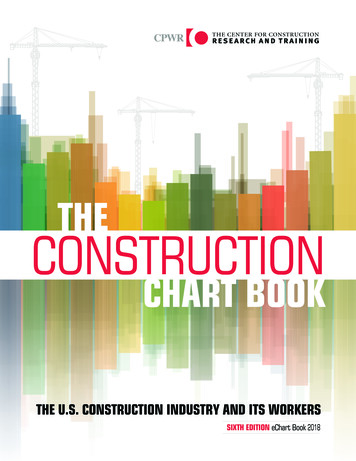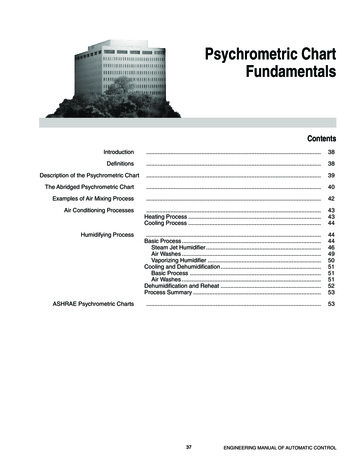
Transcription
THECONSTRUCTIONCHART BOOKTHE U.S. CONSTRUCTION INDUSTRY AND ITS WORKERSSIXTH EDITION eChart Book 2018
2018THE C ONSTRUCTION C HART B OOKThe U.S. Construction Industry and Its WorkersSixth EditionFebruary 2018
2018, CPWR – The Center for Construction Research and Training. All rights reserved.This publication was made possible by grant number OH009762 from the National Institute for Occupational Safety and Health(NIOSH). The contents are solely the responsibility of the authors and do not necessarily represent the official views of NIOSH.CPWR – the research and training arm of NABTU – is uniquely situated to serve workers, contractors, and the scientific community.A core function of CPWR’s work is to improve safety and health in the construction industry. This volume is part of that effort.To obtain permission to use portions of this book, contact:PublicationsCPWR – The Center for Construction Research and Training8484 Georgia Ave.Suite 1000Silver Spring, MD 20910301-578-8500This chart book is posted at www.cpwr.com.Address correspondence to: Xiuwen (Sue) Dong, Dr.P.H., at cpwrwebsite@cpwr.com.
FOREWORDToday, we have access to knowledge sourcesworldwide in a matter of seconds. Yet with all thisinformation, we still seem to have a deficit of factsthat we can use with absolute surety of their accuracy.So we take special pleasure in writing a foreword to abook of numbers based in facts.The Construction Chart Book: The U.S. ConstructionIndustry and Its Workers delivers an assessmentof where we stand as an industry, based on themost recent data available from trusted public andprivate sources. The book covers constructionindustry economics, demographics, and changes toemployment and training, in addition to safety hazardsand dangerous chemicals that can compromise lifeand health. In short, this book examines aspectsof construction that affect every man and womanworking in our industry.This sixth edition sheds light on issues that havearisen in the last few years. With facts and charts wesee trends and identify issues that affect workers andindustry. If you want to know about unionization inthe construction industry, go to page 12, which tellsyou that about 1.2 million construction workers wereunion members in 2016, 100,000 more than in 2015;and union market share reached 42% to 50% in theHeavy Civil/Industrial sector. Where can you find thenumber of U.S. construction workers who’ve goneback to work since the economic downturn? Page 20.Page 22 shows the percentage of construction workerswho are self-employed dipped from 19% in 2010 to16% in 2015. That change may look like good news,but it means 1.6 million construction workers are stillclassified under that category in our industry. Theyaren’t protected by OSHA. When they suffer an injury,they are on their own, with no workers’ compensationto cover medical and lost-time expenses. We alsosee that while the overall nonfatal injury trend inconstruction is declining, falls continue to kill ordisable construction workers. Fall prevention remainsa big challenge for our industry.THE CONSTRUCTION CHART BOOK,SIXTH EDITIONThose of us in North America’s Building TradesUnions (NABTU) are proud to point to the book’spublisher: CPWR – The Center for ConstructionResearch and Training, a not-for-profit institutioncreated by our organization. CPWR’s researchproducts, whether a report, website, conferencesummary, or this book, are available online at nocharge. We are prouder still to see this informationoffered to all parties interested in the constructionindustry – owners, contractors, associations,government, academia, and of course unions andworkers, union and non-union alike. CPWR is able tooffer this top-quality research through its cooperativeagreement with one of our nation’s most importantfederal agencies, whose work often goes unnoticed,the National Institute for Occupational Safety andHealth (NIOSH).We’ll end with the sobering statistics found on page38. Our industry remains top in the number of workerskilled on the job in this nation. This alone shouldmake all of us who care about construction workerstake a look at this book – and the work of CPWR. It’severyone’s business to make our worksites safer andhealthier for all.SEAN MCGARVEYPresident, North America’s Building Trades UnionsBoard Chair and President, CPWRBRENT BOOKERSecretary-Treasurer, North America’s BuildingTrades UnionSecretary-Treasurer, CPWRCHRISTINA TRAHAN CAINExecutive Director, CPWRiii
CSDAFWDALYdBADOEDOLECIeLCOSHEPAENMivAdult Blood Lead Epidemiologyand Surveillance ProgramAffordable Care ActAmerican Community SurveyAmerican Time Use SurveyBureau of Economic AnalysisBeryllium sensitivityBlood lead levelBureau of Labor StatisticsBody mass indexBehavioral Risk Factor SurveillanceSystemBuilding Trades National MedicalScreening ProgramChronic beryllium diseaseCounty Business PatternsCenters for Disease Controland PreventionCurrent Employment StatisticsCensus of Fatal Occupational InjuriesCivilian Health and Medical Programof the Uniformed ServicesCivilian Health and Medical Programof the Department of Veterans AffairsChronic obstructive pulmonary diseaseConsumer Price IndexUrban Wage Consumer Price IndexCurrent Population SurveyCenter for Workers’ CompensationStudiesDays away from workDisability-adjusted life yearA-weighted decibelsU.S. Department of EnergyU.S. Department of LaborEmployment Cost IndexElectrical Library of ConstructionOccupational Safety and HealthEnvironmental Protection AgencyEngineered CSNASINCHSNCSNEPNECNHISNIHLNIOSHNNINORAEmployment Training AdministrationFederal Reserve Economic DataFull-time equivalent workerGross Domestic ProductGross Domestic Product: Implicit PriceDeflatorGovernment Services AdministrationHuman Immunodeficiency VirusHearing protection devicesHealth and Retirement StudyInternational Labour OrganizationIntegrated Management InformationSystemInternal Revenue ServiceInternational Standard IndustrialClassificationJob Openings and Labor TurnoverSurveyLeadership in Energy andEnvironmental DesignLocal exhaust ventilationMedical Expenditure Panel SurveyMexican Migration ProjectMicrograms per deciliterMicrograms per meter cubedMusculoskeletal disordersNorth America’s Building Trades UnionsNorth American Industry ClassificationSystemNational Academy of Social InsuranceNational Center for Health StatisticsNational Compensation SurveyNano-enhanced productsNot elsewhere classifiedNational Health Interview SurveyNoise-induced hearing lossNational Institute for OccupationalSafety and HealthNational Nanotechnology InitiativeNational Occupational Research AgendaTHE CONSTRUCTION CHART BOOK, SIXTH EDITION
ABBREVIATIONS TLVTWIUSGBCWBVWHDWMSDOccupational Employment StatisticsOccupational Hearing LossOccupational Injury and IllnessClassification SystemOccupational Information NetworkOccupational Safety and HealthAdministrationOSHA Training InstitutePermissible exposure limitPersonal fall arrest systemsPatient Protection and AffordableCare ActPersonal protective equipmentPew Research CenterPrevention through DesignQuarterly Census of Employment andWagesRegistered Apprenticeship PartnersInformation Management Data SystemRecommended exposure levelRevised NIOSH Lifting EquationResearch to practiceState Apprenticeship AgencySafety voice for ergonomics projectSurvey of Business OwnersStandard Industrial ClassificationStandard Occupational ClassificationSurvey of Occupational Injuries andIllnessesSevere Violator Enforcement ProgramSerious, willful, and repeatThreshold limit valueTemporary Worker InitiativeU.S. Green Building CouncilWhole body vibrationWage and Hour DivisionWork-related musculoskeletal disorderTHE CONSTRUCTION CHART BOOK, SIXTH EDITIONv
CONTENTSiiiForewordivAbbreviationsviiDetailed Contents of the ConstructionChart Book, Sixth EditionxviIntroductionxviiMain FindingsTOpIcS1Industry Summary10Labor Force Characteristics20Employment and Income29Education and Training32Hazards and Exposures37Fatal and Nonfatal Injuries50Occupational Diseases52OSHA Enforcement and Injury Costs55Health Indicators and Services57Annex: How to Calculate the “Real” Wage58References66Glossary73AcknowledgementsviTHE CONSTRUCTION CHART BOOK, SIXTH EDITION
DETAILED CONTENTS OF THE CONSTRUCTION CHART BOOKSixth EditionINDUSTRY SUMMARY1. Industrial Classification1a. NAICS six-digit classification structure1b. Comparison of the North American IndustryClassification System2.Payroll Establishments and Employees inConstruction2a. Number and percentage of construction establishments and employees, by establishment size, 2012(With payroll)2b. Number of construction establishments, 1977-2012(With payroll)2c. Number of construction employees, 1977-2012(With payroll)3. Nonemployer Establishments in Construction3a. Percentage of construction establishments with andwithout payroll, 20123b. Share of dollar value produced in constructionestablishments with and without payroll, 20123c. Number of establishments in selected constructionsectors with and without payroll, 20123d. Dollar value of construction work produced,selected construction sectors with and withoutpayroll, 20123e. Nonemployer establishments as a percentage of allconstruction establishments, by state, 20124. Value Produced and Expended in Construction4a. Real value added by construction and as a percentage of GDP in the U.S., 2002-2015 (2009 dollars)4b. Chain-type price indices for value added by industry,2003-20154c. Payroll and fringe benefits as a percentage of thevalue of construction work done, 1977-20124d. Where construction dollar value goes, 2012 (Payrollestablishments)5.Construction Spending: Private and PublicSector5a. Value of construction, private versus public sector,1993-2015 (2015 dollars)THE CONSTRUCTION CHART BOOK, SIXTH EDITION5b. Share of dollar value of private sector construction,by type, 20155c. Value of private nonresidential construction, byregion, 1993-2015 (2015 dollars)5d. Share of dollar value of public sector construction,by type, 20156.6a.6b.6c.6d.7.7a.7b.7c.7d.7e.Private Residential and NonresidentialConstructionValue of private construction, residential versusnonresidential, 1993-2015 (2015 dollars)Value of private residential construction, by type,1993-2015 (2015 dollars)Number of housing starts, 1993-2015Residential construction as a percentage of workdone, selected specialty trades, 2012Demographics of Business Owners in Constructionand All IndustriesWomen-owned firms as a percentage of the total,construction versus all industries, 2012Hispanic-owned firms as a percentage of the total,construction versus all industries, 2012African American-owned firms as a percentage of thetotal, construction versus all industries, 2012Other minority-owned firms as a percentage of thetotal, construction versus all industries, 2012Age distribution among business owners, construction versus all industries, 20128. Characteristics of Construction Businesses8a. Years construction businesses were established,Hispanic-owned firms versus all firms, 20128b. Sources of capital needed to start a business inconstruction, 20128c. Types of businesses in construction, employer versusnonemployer, 20128d. Internet involvement in construction businesses,employer versus nonemployer, 20128e. Types of workers in construction businesses, employerversus nonemployer, 2012vii
8f.Paid day laborers in Hispanic and non-Hispanicowned construction businesses, employer versusnonemployer, 20129.9a.9b.9c.9d.9e.Green Construction in the United StatesLEED-certified projects, 2000-2015, selected yearsOwner of LEED-registered projects, 2000-2015LEED-certified square feet, by region, 2000-2015LEED-certified square feet per capita, by state, 2015New single-family home builder involvement ingreen activities, 2013-2020 (projected)9f . Most trusted sources of information about greenbuilding practices and products, 2014LABOR FORCE CHARACTERISTICS10. Labor Force Structure and Definitions10a. Type of labor force and class of workers, construction and all industries, 201510b. Distribution of class of worker in the constructionworkforce, 2010 and 201511. Occupational Classifications and EmploymentDistributions in Construction11a. Percentage of all construction employees that meetthe Economic Census definition of “constructionworker”, 1967-2012 (With payroll)11b. Workers by occupational classification and distribution in construction, 2015 (16 years and older)12. Union Membership and Coverage inConstruction and Other Industries12a. Union membership and coverage in constructionand other industries, 2015 and 201612b. Union membership and coverage in construction,public versus private sector, 2015 and 201612c. Union membership, selected construction occupations, 201512d. Subject Matter Experts ratings for each union foreach sector12e. Union market share for the Heavy Civil/Industrialsector, 2005-201212f. Percentage of construction workers who are unionmembers, by state, 2013-2015 average13. Worker Age in Construction and OtherIndustries13a. Average age of workers, construction versus allindustries, 1985-2015 (All employment)viii13b. Average age of workers, by industry, 2015(Wage-and-salary workers)13c. Age distribution in construction, selected years,1985-2015 (All employment)13d. Age distribution in all industries, projected through2024 (All employment)14. Age of Construction Workers by Union Status,Hispanic Ethnicity, Type of Employment, andOccupation14a. Age distribution in construction, by union status,2015 (Production workers)14b. Age distribution in construction, by Hispanic ethnicity, 2010 versus 2015 (All employment)14c. Age distribution in construction, wage-and-salaryversus self-employed workers, 2015(All employment)14d. Construction workers aged 55 years, selectedconstruction occupations, 2015 (All employment)15. Foreign-born Workers in Construction andOther Industries15a. Percentage of foreign-born workers, by industry,2015 (All employment)15b. Birthplace of foreign-born construction workers,2015 (All employment)15c. Percentage of workers who spoke a language otherthan English at home, by industry, 2015(All employment)15d. Year of entry for immigrant construction workers inthe U.S., 2015 (All employment)16. Hispanic Workers in Construction and OtherIndustries16a. Hispanic workers as a percentage of the workforce,construction versus all industries, selected years,1990-2015 (All employment)16b. Number of Hispanic workers in construction,selected years, 1990-2015 (All employment)16c. Percentage of Hispanic workers, by industry, 2015(Production workers)16d. Percentage of Hispanic construction workers, bystate, 2015 (All employment)17. Hispanic Workers in Construction Occupations17a. Occupational distribution in construction, by Hispanicethnicity, 2015 (All employment)THE CONSTRUCTION CHART BOOK, SIXTH EDITION
17b. Distribution of Hispanic workers among constructionoccupations, 2013-2015 average (All employment)17c. Hispanic workers as a percentage of the workforce,selected construction occupations, 2013-2015 average (All employment)17d. Union membership among construction workers, byHispanic ethnicity, 2015 (Wage-and-salary workers)18. Racial Minorities as a Worker Group inConstruction and Other Industries18a. Members of racial minorities as a percentage ofworkers, by industry, 2015 (Wage-and-salary workers)18b. Members of racial minorities as a percentage ofworkers, by selected construction occupations, 2015(All employment)18c. Occupational distribution among racial minorityworkers in construction, 2015 (All employment)19. Women Workers in Construction and OtherIndustries19a. Number of women workers in construction, selectedyears, 1985-2015 (All employment)19b. Women as a percentage of workers, by industry,2015 (All employment)19c. Women as a percentage of workers, selectedindustries, 2015 (Production occupations)19d. Distribution of women workers in construction, byoccupation type, 1985, 2010, and 2015(All employment)EMPLOYMENT AND INCOME20. Employment and Unemployment in Constructionand Other Industries20a. Construction employment, payroll employmentversus all employment, 1992-201520b. Year-over-year change in payroll employment,construction versus all nonfarm industries, 1992201520c. Percent change in payroll employment since 1992,by construction sector, 1992-201520d. Percent change in payroll employment since 2001,residential versus nonresidential building construction, 2001-201520e. Number of payroll employees in residential specialtytrade, 2005-2015THE CONSTRUCTION CHART BOOK, SIXTH EDITION20f. Monthly unemployment rate, construction versusall nonfarm industries, 2005-2015 (Not seasonallyadjusted; private wage-and-salary workers)21. Temporary Workers in Construction and OtherIndustries21a. Temporary workers as a percentage of the workforce, construction versus non-construction, 2003201421b. Temporary workers as a percentage of the workforce, by major industry, 2011-2014 average21c. Work arrangements, construction versus all industries, 201521d. Demographics of construction workers, temporaryversus regular employment, 2011-2014 average21e. Employment characteristics of construction workers,temporary versus regular employment, 2011-2014average22. Self-Employment in Construction and OtherIndustries22a. Unincorporated self-employment as a percentage ofthe workforce, construction versus all nonfarmindustries, 1995-201522b. Percentage of self-employed workers, selectedconstruction occupations, 201522c. Number of individual proprietorships in construction, 2002-201422d. Employee misclassification legislation, by state,2010-201623. Employment Costs in Construction and OtherIndustries23a. Index of labor costs, construction versus all industries,2001-2015 (Seasonally adjusted: private industry)23b. Average hourly wage, construction versus allindustries, 2006-2016 (Private industry; 2016 dollars)23c. Average hourly labor costs, by industry, December2015 (Private industry)23d. Average hourly labor costs in construction, by unionstatus, March 2016 (Private industry)23e. Average hourly labor costs, residential versus nonresidential specialty trades, 2016 (Private industry)24. Wages in Construction, by DemographicCharacteristics, Unionization, and Region24a. Average hourly wage in construction, by race/ethnicityand union status, 2015 (Production workers)ix
24b. Average hourly wage in construction, by age group,2015 (Production workers)24c. Average hourly wage in construction, by educationalattainment, 2015 (Production workers)24d. Average hourly wage in construction, by gender andunion status, 2013-2015 average (Production workers)24e. Average hourly wage in construction, by region andunion status, 2015 (Production workers)25. Standard Occupational Classification and WageEstimates in Construction25a. Average hourly wage, by construction occupation,2015 (Wage-and-salary workers)25b. Hourly and annual wages, by construction subsector,2015 (Wage-and-salary workers)25c. Hourly wage, by construction subsector andoccupation, 2015 (Wage-and-salary workers)26. Health Insurance Coverage in Construction andOther Industries26a. Percentage of workers with health insurance, bysource and industry, 201526b. Number and rate of uninsured construction workers,selected years, 1999-201526c. Percentage of construction workers with employment-based health insurance, by demographiccharacteristics, 201526d. Percentage of construction workers with private andemployment-based health insurance, by union status,201526e. Percentage of workers with employment-basedhealth insurance, by company size, 201526f. Percentage of construction workers with employmentbased health insurance, selected occupations, 201527. Retirement Plans in Construction and OtherIndustries27a. Participation level in employment-based retirementplans, by industry, 2015 (Wage-and-salary workers)27b. Participation level in employment-based retirementplans in construction, by union status, 2015 (Production workers)27c. Participation level in employment-based retirementplans, selected construction occupations, 2015(Wage-and-salary workers)x27d. Distribution of participants in single employer andmultiemployer retirement savings plans in construction, 201428. Hours Worked, Overtime, and Time Use inConstruction and Other Industries28a. Average hours worked per week, constructionversus all nonfarm industries, 1985-2015(Private production workers)28b. Percentage of employees working overtime, byindustry, 2015 (All employment)28c. Hours worked per week in construction, self-employedand wage-and-salary workers, 2015(All employment)28d. Time use in a 24-hour period, construction versus allindustries, 2013-2015 average (All employment)EDUCATION AND TRAINING29. Educational Attainment and Internet Usage inConstruction and Other Industries29a. Percentage of employees who have at least a highschool diploma, by industry, 2015 (All employment)29b. Distribution of educational attainment amongconstruction workers, by union status, 2015 (Production workers)29c. Distribution of educational attainment amongconstruction workers, by Hispanic ethnicity, 2015(All employment)29d. Percentage of workers with access to the internet, byindustry, 2015 (All employment)29e. Household computer use in construction versus allindustries, by type of device, 201530. Apprenticeships and Occupational Training inConstruction30a. Joint labor-management apprenticeship programs, bystate, 2016 (Share of all active programs)30b. New registrations in construction apprenticeshipprograms, union versus non-union programs, 2006201630c. Number of Hispanic construction workers amongnew apprenticeship registrations, union versus nonunion programs, 2006-201630d. Number of new registrations in construction apprenticeship programs, by race and ethnicity, 201630e. Number of active apprentices, selected constructionoccupations, 2016THE CONSTRUCTION CHART BOOK, SIXTH EDITION
30f. Number of new registrations in construction apprenticeship programs, by gender and union status, 201631. Employment Projections and Current UnfilledJobs in Construction31a. Percentage of projected employment change, byindustry, 2014-202431b. Percentage of projected employment change,selected construction occupations, 2014-202431c. Percentage of projected replacement needs, selectedconstruction occupations, 2014-202431d. Projected numbers of job growth and replacementneeds, selected construction occupations, 2014-202431e. Job openings, separations, and hires in construction,2006-2016 (Seasonally adjusted)34. Exposure to Silica and Other Contaminants inConstruction34a. Percentage of workers exposed to silica, by exposurelevel, construction versus all industries (Microgramsper meters cubed)34b. Percentage of construction workers exposed tosilica, by exposure level and construction subsector(Micrograms per meters cubed)34c. Distribution of silica exposures among constructionworkers, by level and activity (Micrograms per meterscubed)34d. Exposure to contaminants (such as pollutants,gases, dust, or odors) at work, selected occupations35.HAZARDS AND EXPOSURES35a.32. O*NET Database and Occupational Exposures inConstruction32a. Working at heights on the job, selected occupations32b. Climbing ladders, scaffolds, or poles at work, selected occupations32c. Keeping/regaining balance at work, selected occupations32d. Exposure to hazardous conditions at work, selectedoccupations32e. Percentage of construction workers exposed to hazards, by exposure level (Production workers)35b.33. Exposure Risks for Work-Related Musculoskeletal Disorders and Other Illnesses in Construction33a. Bending/twisting and repetitive motions at work,selected occupations33b. Kneeling, crouching, stooping, or crawling at work,selected occupations33c. Cramped work space/awkward positions at work,selected occupations33d. Exposure to whole body vibration at work, selectedoccupations33e. Percentage of construction workers using hands tohandle, control, or feel objects, tools, or controls, byexposure level (Production workers)33f. Percentage of construction workers exposed to veryhot or very cold temperatures, by exposure level(Production workers)THE CONSTRUCTION CHART BOOK, SIXTH EDITION35c.35d.Engineered nanomaterials in the U.S.construction industryDistribution of products in CPWR’s eLCOSH nanoinventoryNumber and type of nanomaterials reported inCPWR’s eLCOSH nano inventoryAwareness of nanotechnology among union construction health and safety trainers (2014 to 2017)Distribution of National Nanotechnology Initiative(NNI) funding by program component area, 201836. Lead Exposure in the Construction Industry36a. Distribution of workers with BLLs 10 μg/dL, byindustry, 2016 (18 states)36b. Prevalence rate of workers with BLLs 10 μg/dLin construction, 2011-201636c. Number of workers with BLLs 10 μg/dL, by construction subsector, 2016 (13 states)36d. Prevalence rate of construction workers with BLLs 10 μg/dL, by state, 2016 (12 states)FATAL AND NONFATAL INJURIES37.Fatal and Nonfatal Construction Injuries inSelected Industrial Countries37a. Rate of fatalities in construction, selected countries,201337b. Rate of nonfatal injuries in construction, selectedcountries, 201337c. Factors and criteria of construction fatalities andnonfatal injuries, selected countries, 2013xi
0a.40b.40c.40d.xiiFatal and Nonfatal Injuries in Construction andOther IndustriesNumber of fatalities, by major industry, 2015(All employment)Number of fatalities in construction, selected yearsbetween1992 and 2015 (All employment)Rate of fatalities, selected industries, selected yearsbetween 1992 and 2015 (All employment)Number of nonfatal injuries resulting in days awayfrom work in construction, selected years between1992 and 2015Rate of nonfatal injuries resulting in days awayfrom work, by major industry, 2015Rate of nonfatal injuries resulting in days awayfrom work, selected industries, selected years between 1992 and 2015Fatal and Nonfatal Injuries among Construction SectorsNumber and percentage of fatalities among majorconstruction sectors,* 2015 (Private wage-and-salaryworkers)Rate of fatalities, by major construction sector,*2003-2015 (Private wage-and-salary workers)Number and percentage of nonfatal injuries resulting in days away from work among major construction sectors,* 2015 (Private wage-and-salaryworkers)Rate of nonfatal injuries resulting in days awayfrom work, by major construction sector,* 20032015 (Private wage-and-salary workers)Fatal and Nonfatal Injuries in Construction byEmployment, Establishment, and GeographicTrendsNumber of fatalities in construction, by class ofworker, 1992-2015, selected years (All employment)Distribution of construction fatalities and employment, by establishment size, 2015 (Wage-and-salary workers)Rate of nonfatal injuries resulting in days awayfrom work in construction, by establishment size,1994-2015 (Private wage-and-salary workers)Rate of fatalities in construction, by state, 20112015 average (All employment)40e. Rate of nonfatal injuries resulting in days awayfrom work in construction, by state, 2011-2015average (Private wage-and-salary 42d.43.43a.43b.43c.43d.Demographic Trends of Fatal and NonfatalInjuries in ConstructionDistribution of fatalities in construction, by agegroup, selected years (All employment)Distribution of nonfatal injuries resulting in daysaway from work in construction, by age group,selected years (Private industry)Rate of fatal and nonfatal injuries in construction,by age group, 2013-2015 averageMedian days away from work by age group,construction versus all industries, 2015Rate of fatalities in construction, by Hispanicethnicity, four time periods from 1992-2015(All employment)Rate of nonfatal injuries in construction, by Hispanic ethnicity, four time periods from 1992-2015Fatal and Nonfatal Injuries within ConstructionOccupationsNumber of fatalities, selected construction occupations, 2011-2015 total (All employment)Number of nonfatal injuries resulting in days awayfrom work, selected construction occupations, 2015(Private wage-and-salary workers)Rate of fatalities, selected construction occupations,2011-2015 average (All employment)Rate of nonfatal injuries resulting in days away fromwork, selected construction occupations, 2011-2015average (Private wage-and-salary workers)Leading Causes of Fatal and Nonfatal Injuries inConstructionDistribution of leading causes of fatalities inconstruction, 2015 (All employment)Distribution of leading causes of nonfatal injuriesresulting in days away from work in construction,2015 (Private wage-and-salary workers)Leading causes of fatalities in construction, 19922015 (All employment)Rate of leading causes of nonfatal injuries resultingin days away from work in construction, 1992-2015(Private wage-and-salary workers)THE CONSTRUCTION CHART BOOK, SIXTH EDITION
44.44a.44b.44c.44d.44e.Fatal Injuries from Falls to a Lower Level inConstructionNumber and rate of fatal falls to a lower level inconstruction, 2003-2015 (All employment)Fatal falls to a lower level in construction, byheight of fall, 2011-2015 totalFatal falls to a lower level in construction, byprimary source, 2011-2015 totalDistribution of fatalities from falls to a lower levelin construction, by establishment size, 2011-2015total (Wage-and-salary workers)Number and rate of work-related fatalities fromfalls to a lower level in construction, selected occupations, 2011-2015 total45. Nonfatal Injuries from Falls in Construction45a. Number of nonfatal injuries due to falls, slips, andtrips involving days away from work
7e. Age distribution among business owners, construc- tion versus all industries, 2012 8. Characteristics of Construction Businesses 8a. Years construction businesses were established, Hispanic-owned irms versus all irms, 2012 8b. Sources of capital needed to start a business in construction, 2012 8c.










